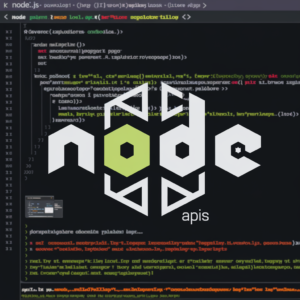Deploying a Node.js application involves preparing your code for production, choosing a hosting platform, and setting up automated deployment and monitoring. This chapter will guide you through preparing your application for production, deploying on popular cloud platforms like Heroku and AWS, setting up Continuous Integration/Continuous Deployment (CI/CD) pipelines, and monitoring and scaling your application.
Preparing Your Application for Production
Before deploying your Node.js application, ensure it is production-ready by addressing the following aspects:
1. Environment Configuration:
- Environment Variables: Use environment variables to manage configuration settings such as API keys and database credentials. Tools like
dotenvcan help manage these variables in development. - Configuration Files: Separate configuration files for different environments (development, testing, production) to manage settings appropriately.
2. Error Handling:
- Graceful Error Handling: Implement error handling to catch and log errors. Use middleware or error-handling functions to manage errors and send appropriate responses to clients.
- Logging: Utilize logging libraries like
winstonormorganto record application logs and errors for troubleshooting.
3. Security:
- HTTPS: Ensure your application uses HTTPS to encrypt data transmitted between the client and server. Many cloud platforms offer free SSL certificates.
- Security Headers: Use security headers such as Content Security Policy (CSP) and XSS Protection to protect your application from various attacks.
4. Performance Optimization:
- Minify and Bundle: Minify and bundle your JavaScript and CSS files to reduce load times. Tools like
webpackcan assist in this process. - Caching: Implement caching strategies to improve performance and reduce server load.
Deploying on Cloud Platforms
1. Deploying on Heroku
Heroku is a cloud platform that simplifies deployment and scaling of applications. Follow these steps to deploy a Node.js application on Heroku:
Step 1: Install Heroku CLI
npm install -g heroku
Step 2: Create a Heroku Application
heroku create
Step 3: Add a Procfile Create a Procfile in the root of your project to specify the command to run your application:
web: node app.js
Step 4: Deploy Your Code
git add .
git commit -m "Initial commit"
git push heroku main
Step 5: Scale Your Application
heroku ps:scale web=1
Step 6: Open Your Application
heroku open
2. Deploying on AWS
Amazon Web Services (AWS) provides a wide range of services for deploying Node.js applications. AWS Elastic Beanstalk is a popular service for deploying and managing applications.
Step 1: Install AWS CLI
pip install awscli
Step 2: Configure AWS CLI
aws configure
Step 3: Create an Elastic Beanstalk Application
eb init
Step 4: Create and Deploy Your Environment
eb create my-node-app
eb deploy
Step 5: Open Your Application
eb open
Setting Up CI/CD Pipelines for Automated Deployment
Continuous Integration (CI) and Continuous Deployment (CD) automate the process of testing and deploying your application.
1. Set Up a CI/CD Pipeline with GitHub Actions
GitHub Actions allows you to automate workflows, including building, testing, and deploying your application.
Step 1: Create a Workflow File
Create a .github/workflows/deploy.yml file in your repository with the following content:
name: Deploy Node.js Application
on:
push:
branches:
- main
jobs:
build-and-deploy:
runs-on: ubuntu-latest
steps:
- name: Checkout code
uses: actions/checkout@v3
- name: Set up Node.js
uses: actions/setup-node@v3
with:
node-version: '14'
- name: Install dependencies
run: npm install
- name: Run tests
run: npm test
- name: Deploy to Heroku
env:
HEROKU_API_KEY: ${{ secrets.HEROKU_API_KEY }}
run: |
git remote add heroku https://git.heroku.com/<your-heroku-app>.git
git push heroku main
2. Configure Secrets
Add your Heroku API key to your repository’s secrets in GitHub under Settings > Secrets and variables > Actions.
Monitoring and Scaling Your Node.js Application
1. Monitoring
Monitoring helps you track the health and performance of your application. Use tools such as:
- New Relic: Provides performance monitoring and application insights.
- Datadog: Offers monitoring, logging, and alerting.
- Loggly: Helps manage and analyze logs.
2. Scaling
As your application grows, you may need to scale it to handle increased traffic:
- Vertical Scaling: Increase the resources (CPU, RAM) of your instance.
- Horizontal Scaling: Add more instances to handle traffic. Most cloud platforms allow easy scaling options.
Heroku Scaling:
heroku ps:scale web=2
AWS Elastic Beanstalk Scaling:
eb scale 2
Conclusion
Deploying a Node.js application involves preparing your code for production, selecting the right cloud platform, setting up automated deployment pipelines, and monitoring and scaling your application. By following these practices, you can ensure that your application runs smoothly and efficiently in a production environment, delivering a reliable experience to your users.
Tags
#Nodejs #Deployment #CloudPlatforms #Heroku #AWS #CI/CD #GitHubActions #ContinuousIntegration #ContinuousDeployment #WebDevelopment #JavaScript #ApplicationMonitoring #Scaling #DevOps #TechTutorial #SoftwareDeployment #CloudComputing





